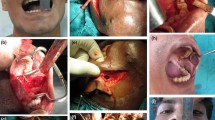Abstract
Objectives
To study the usefulness of bilateral inferiorly based nasolabial flap in the management of advanced oral submucous fibrosis in patients with interincisal opening (IIO) 15mm.
To measure the Interincisal Opening (IIO), preoperatively, intra-operatively and at regular intervals during the follow-up period.
To assess the vascularity and viability of the flap on the 1st, 7th and 21st postoperative days.
Methods
6 medically fit patients with a chief complaint of restricted mouth opening and interincisal opening less than 15 mm were chosen for the study. All the cases were diagnosed as advanced oral submucous fibrosis based on longstanding positive history of habits (chewing tobacco, betel nut etc.), clinical examination and histopathological examination.
Intra-oral incisions were taken on the buccal mucosa for release of bands. All third molars were extracted. Bilateral intra-oral coronoidectomy was done if IIO less than 35 mm was achieved intraoperatively. Bilateral nasolabial flaps were raised in the supramuscular plane and transferred intra-orally through a transbuccal tunnel. Periodic evaluation of the interincisal opening and pin prick test of the flap (to assess vascularity) was carried out.
Results
There was no incidence of infection in the transferred flap and the recipient site in all cases. Complications due to vascularity (blue flap or white flap) were not encountered. In our series of nasolabial flaps, flap loss either complete or partial was not encountered. Other complications like flap necrosis, damage to parotid duct, ectropion were not observed.
After release of fibrotic bands a mean forced intraoperative mouth opening of 41.7 mm was achieved. On the first postoperative day a mean unforced mouth opening of 21.7 mm was achieved. Mean mouth opening of 39.6 mm was achieved at 6 months, with a mean increase of 26.8 mm.
Two of our cases required coronoidectomy since the intraoperative mouth opening achieved was less than 35mm.
Conclusion
The nasolabial flap is a versatile flap, which can be successfully used in the reconstruction of defects created after the release of fibrotic bands. This flap is a good solution for the functional problems but the inevitable scar created becomes a drawback and may require a revision.
All the cases treated for oral submucous fibrosis using bilateral nasolabial flaps showed adequate mouth opening at 6 months postoperatively, recommending its use.
Similar content being viewed by others
References
Cox SC, Walker DM (1996) Oral submucous fibrosis. A review. Aust Dent J 41(5): 294–299
Balaji SM (2004) Comparison of nasolabial and tongue flaps in the correction of OSMF. J Maxillofac Oral Surg 3(1): 12–17
Cox SC, Walker DM (1997) Establishing a normal range of mouth opening: its use in screening for oral submucous fibrosis. Br J Oral Maxillofac Surg 35(1): 40–42
Ducic Y, Burye M (2000) Nasolabial flap reconstruction of oral cavity defects: A report of 18 cases. J Oral Maxillofac Surg 58(10): 1104–1108
Morgan RF, Chambers RG, Jaques DA, Hoopes JE (1981) Nasolabial flap in intra-oral reconstruction — Review of 55 cases. Am J Surg 142(4): 448–450
Kavarana NM, Bhathena HM (1987) Surgery for severe trismus in submucous fibrosis. Br J Plast Surg 40(4): 407–409
Elliott RA Jr (1976) Use of nasolabial skin flap to cover intra-oral defects. Plast Reconstr Surg 58(2): 201–205
Author information
Authors and Affiliations
Corresponding author
Rights and permissions
About this article
Cite this article
Kshirsagar, R., Chugh (Modi), A. & Rai, A. Bilateral inferiorly based nasolabial flaps for the management of advanced oral submucous fibrosis. J. Maxillofac. Oral Surg. 9, 22–26 (2010). https://doi.org/10.1007/s12663-010-0008-9
Published:
Issue Date:
DOI: https://doi.org/10.1007/s12663-010-0008-9




